Perpetual Change
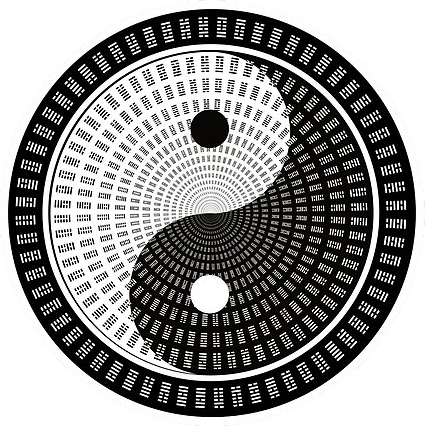
An essay on the four timeless hexagrams of the I Ching
Within the sequence of 64 symbols in the ancient Chinese Book of Changes, four stand out as being special. They represent the archetypal concepts of Heaven & Earth, Yáng & Yīn. Together they provide timeless wisdom on how to remain uniquely authentic in the midst of eternal change.
And one peculiar point I see,
As one of many ones of me
As truth is gathered, I rearrange,
Inside out, outside in,
Inside out, outside in,
Perpetual change.
— Yes
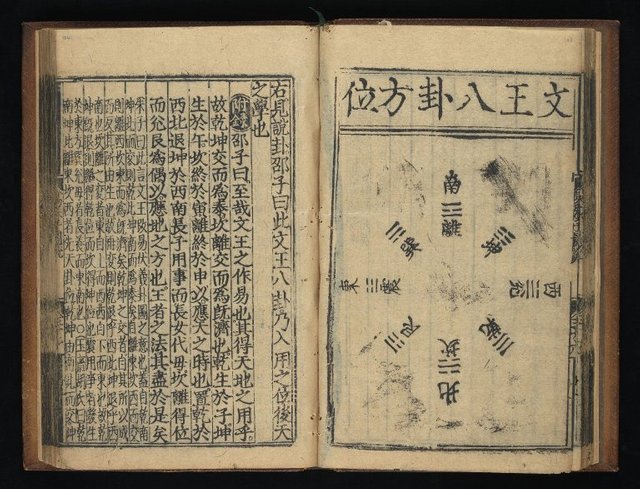 A copy of the I Ching printed in 1440, China.
A copy of the I Ching printed in 1440, China.
I'm now halfway through my 64-week journey with the I Ching. Thirty-two weeks ago, I woke up one Monday morning with the sudden inspiration to spend each day reading, contemplating, and embodying the wisdom of the Book of Changes. The project started very differently to what it is for me now, although even back then I knew that it would evolve and change week after week, for that is the nature of the Dào, as described by the I Ching.
Today, I completed my work with the Upper Canon, which comprises the first 30 hexagrams as sequenced by King Wén, the progenitor of the ancient Zhōu Dynasty back in the 11th Century BCE. I began my journey a couple of days after the June solstice (June 25th). As I write this, the Lunar New Year is just 3 days away. I feel the timing is auspicious.
It is said that the hexagrams of the Upper Canon demonstrate the wisdom of all matters as they pertain to 天 Tiān, Heaven. It suggests that these 30 symbols — and the texts and commentaries associated with them — concern themselves with sacred matters; matters that are archetypal in nature, and would be experienced at every level of existence.
The Upper Canon is bookended by four important hexagrams, which I will describe briefly in this article. Known as the 永恆四卦 yǒnghéng sìguà (the four timeless symbols), they stand outside of the time which the remainder 34 symbols exist in. They form the foundation of later Taoist cosmology, and are integral in understanding Yīnyàng theory and the entire ancient Chinese epistemological paradigm, which Confucianism, Taoism, Legalism, Mohism, Chinese shamanism, Chinese Buddhism, linguistics, medicine, astrology, and the developments of Chinese science and technology owe their existence to.
To understand these ideas is to grasp (as much as one can) the 易Yì (the changes/transformations of everything in existence) and how they happen. It implies the understanding of the nature of 氣 Qì as the effect, substance, or measure of change.
If you lose your way,
Try to find your way;
If you lose your way,
Never find your space.
You might find yourself crawling
Between heaven and earth
— Midnight Oil
Ancient Chinese cosmology 101
There is a primordial state — pure and untouched by the ravages of time and entropy. It is referred to as 先天 xiāntiān, ‘prior, former, or pre-Heaven’. It is any quality that is innate or a priori, and is also used in TCM to refer to the individual’s state either before birth or conception (there are different ideas on this, and depends on one presupposes a non-material existence or not).

In this state, the archetypal polarities are represented by the trigrams (also known as the primary gua) ☰ Qián and ☷ Kūn. In the Primordial Sequence of the trigrams, they form the North–South poles, with the remaking six trigrams becoming variants of a mixing of yīn and yàng lines as secondary polarities. This is described in Section 3 of the 說卦 Shuō Guà — the 8th Wing of the Confucian commentaries on the I Ching.
But of course if there is an ‘earlier Heaven’ then there must also be a ‘later Heaven’, otherwise why name it as such. This is indicative of the paradigm, where there is always the relative polarity to everything that is in existence; even existence has its polarity in non-existence, which was explicitly mentioned in the later Dao De Jing.
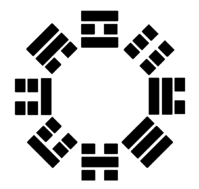
This is then referred to as the Temporal State, or 後天 hòutiān, ‘later or post-Heaven’, and describes anything that is acquired or a posteriori. There is the sense that there is something not-quite-pure or original about this state. It exists in normal, or real time as we experience it, once entropy has begun its natural process on what was once primordial and pure.
The alchemical process
It became the goal of Taoist alchemy to understand where one was in the Temporal State, so that the layers of conditioning could be unravelled to get one back to a pristine, unconditioned state.
In the Temporal State, the north–south polarity is represented by ☵ Kǎn and ☲ Lí, having replaced ☰ Qián and ☷ Kūn respectively. The process was contemporaneous and twofold:
- The essence of ☰ Qián (represented by his unbroken middle line — ) mingled with ☷ Kūn to create ☲ Lí.
- The essence of ☷ Kūn (represented her middle broken line - - ) mingled with ☰ Qián to create ☵ Kan.
In Taoist alchemy, the metaphor of removing the middle lines from ☵ Kǎn and ☲ Lí and putting them back into their original trigrams to form ☰ Qián and ☷ Kūn is a metaphor for the process of shedding the layers of acquired (temporal) conditioning in order to return to one’s true (primordial) nature, before it was influenced by nature / nurture.
And we came up on a bee-keeper,
And he said "Did you know they can change it all?"
You want alchemy.
— Kate Bush
The four timeless symbols
The hexagrams of the I Ching are formed by combining two of the eight primary trigrams (8x8 = 64 possible combinations). The four timeless hexagrams are simply iterations of the four cardinal trigrams: ☰ Qián,☷ Kūn, ☵ Kan, and ☲ Lí.
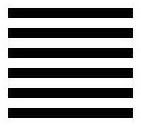 Hexagram 1, 乾 QIÁN, the Initiating
Hexagram 1, 乾 QIÁN, the Initiating
乾 QIÁN is the first hexagram and opens the entire sequence, which is appropriate given its meaning is "the initiating". The image is constructed by doubling the trigram ☰, and represents all aspects of Yáng (Heaven). It is the image of empty space and infinite possibilities. This vast emptiness is what is required for something to start. Imagine needing to start a project; action is not the first step, but instead brainstorming all the potentials, and then considering their possible outcomes. This can be called tàiyáng (greater yang).
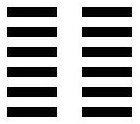 Hexagram 2, 坤 KŪN, the Responding
Hexagram 2, 坤 KŪN, the Responding
坤 KŪN is the second hexagram and is also considered to open the entire sequence. However its meaning comes from the inevitable following on from QIÁN in sequence, and its name means "the responding". The doubling of the trigram ☷ signifies all aspects of Yīn (Earth), and exists to respond to the initiating energy of QIÁN. It essentially represents all the actions of 'responding' to an energy, a suggestion, a plan. It's linked to Earth, because it is the manifestation of what was imagined to begin with in QIÁN. This is tàiyīn (greater yin)
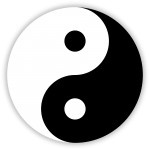
Together, these hexagrams represent Yīnyáng, and the Tàijí symbol (specifically the black and white teardrop shapes). As the opening hexagrams of the I Ching, they form the 'parents', with all other hexagrams being combinations created by mixing the broken and unbroken lines of these two symbols.
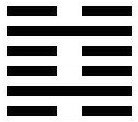 Hexagram 29, 坎 KǍN, the Abyss
Hexagram 29, 坎 KǍN, the Abyss
坎 KǍN is the 29th hexagram, and is formed from the doubling of the trigram ☵. It is associated with the element water (specifically rushing or flowing water) and the moon. The image however is of an abyss or ravine, or darkness: a state of entrapment that we can find ourselves stuck in. The wisdom of this hexagram outlines the advice and approaches to getting ourselves out of such dangerous situations (which I have already written about extensively in my previous post on the Year of the Earth Dog, and my review of that year. This is shàoyáng (lesser yang).
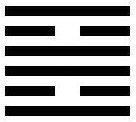 Hexagram 30, 離 LÍ, the Clinging
Hexagram 30, 離 LÍ, the Clinging
離 LÍ is the 30th hexagram and the image is constructed by the repeating of the trigram ☲. Associated with the element fire and the sun, it represents clarity, illumination, and the radiance that brings together (hence an often translated title as "the clinging", in the sense of adhering to something. The idea of two things being paired together is linked with the idea of being able to perceive clearly the nature of the relationship between subject and object. Thus, a much needed quality to have when attempting to accomplish anything in the world. This is shàoyīn (lesser yin).
Both these hexagrams — darkness and light — are formed as the temporal manifestations of their 'primordial parents', initiation and response. They are timeless because in every other moment (the remaining 60 hexagrams) we can find ourselves experiencing either possibilities, responding to the situation, entrapment in darkness, or the clarity about the nature of our attachment to something.
The lines (broken or unbroken) that comprise the structure of the other 60 hexagrams come in four combinations, described as tàiyáng, tàiyīn, shàoyáng, and shàoyīn. That is, they are either stable and unchanging (greater yin/yang), or they are mutable, unstable, and about to change to their polarised state (lesser yin/yang). Each of these four states are represented by these four timeless hexagrams.
You better turn around and blow your kiss hello to life eternal.
— Jeff Buckley
Everything changes
It is by this way that we can use the I Ching to understand the quality of the present moment, and the possible future moments that will emerge from it. The text and its framework was designed to provide advice as to how to adapt to any given moment and how it may change.
The four timeless hexagrams are providing us with the key ingredients of this understanding. We either initiate an action or respond to it; we are separated from others (and ourselves) in darkness or we we connect with others in relationship. These four ingredients, combined together in various measure, provide the essence of every moment we find ourselves in.
The Upper Canon explains the archetypes (according to the ancient Chinese understanding) of how the universe itself works. The first 30 hexagrams — underlined by the four timeless hexagrams — give us the structure of how we experience reality on a bigger-picture level. Heaven was considered an exemplar for human behaviour, and by modelling our ourselves, our values, and our virtues on Heaven it was said that we would become the "superior/accomplished person".
As it states in the Tao Te Ching:
人法地,地法天,天法道,道法自然。Rén fǎ Dì, Dì fǎ Tiān, Tiān fǎ Dào, Dào fǎ zìrán.
Humans [follow] the method of Earth, Earth [follows] the method of Heaven, Heaven [follows] the method of the Way, the Way [follows] the method of it-self-so-ing [its true nature].
Tao Te Ching, chapter 25 (my translation)
Our true nature is unique to us, and is how we 'human' (as a verb), in the same way that the Earth 'earths', Heaven 'heavens', and the Dào 'daos'. This is what is meant by the term 自然 zìrán: to simply be oneself, completely naturally and authentically. And because we have these higher-level exemplars, we don't have to try and be sacred (like Heaven), and we don't have to try and be always changing (like the Dào), because when we embrace our true nature, we will be, and effortlessly so.
For me, the lesson of the Upper Canon is that the 30 hexagrams contained therein are what I can expect to happen all the time in life. They describe the archetypal themes that I and everyone else encounter. The four timeless hexagrams teach me how to manoeuvre through the changes and these situations that I find myself in all the time.
As I sit on the threshold of the new Lunar Year and begin to journey through the Year of the Earth Pig, I feel particularly equipped to adapt to any situation that may arise. Having spent the last 32 (I had two weeks off during that time) weeks learning to perceive and embody the wisdom of the Upper Canon, I feel confident that I can weave through what may emerge and use it to benefit my development as better human being.
I hope there is something in all of this for you to take away and benefit from. Here's to that!
It's been a long, long time coming,
And I know,
Change is gonna come.
— Greta Van Fleet

CREATING YOUR PROFILE IS EASY! JUST FOLLOW THE STEPS HERE ☜(ˆ▿ˆc)


 |  |
|---|
Posted from my blog PANDORA'S LOST GIFT with SteemPress : http://metametheus.net/perpetual-change/
@metametheus has set 2.000 STEEM bounty on this post!

Bounties are a new way you can earn rewards irrespective of you Steem Power. Go here to learn how bounties work.
Earn the bounty by commenting what you think the bounty creator wants to know from you.
Find more bounties here and become a bounty hunter.
Happy Rewards Hunting!
Congratulations to the following winner(s) of the bounty!
Find more bounties here and become a bounty hunter.
Find more bounties here and become a bounty hunter.
Find more bounties here and become a bounty hunter.
Find more bounties here and become a bounty hunter.
Find more bounties here and become a bounty hunter.
Find more bounties here and become a bounty hunter.
I've been interested in Taoism but never got into learning it in depth beyond reading Lao Tzu quotes which I greatly related with. You write some really good content. Resteemed for visibility and followed you for more.
Thanks for the vote, the comment, and the resteem.
Lao Zi was definitely my gateway, even though I’d already been exposed to the I Ching briefly.
While most of what I write is not about the I Ching it certainly is a highly influential undercurrent to all my thinking and creative work.
Looking forward to reading more of your stuff too.
😊🙏🏽☯️
Posted using Partiko iOS
Omg there's for me a such a 'heavy' reading, i had to reading 3 times to merely understand.
Im interesting in learn more and of course i will follow your post for mor information.
Thank you!
Yeah, I understand... its taken me 20 or so years to finally understand the intricacies of this material. Learning how to translate and understand ancient Chinese language is also very helpful 😉.
I have a few I Ching-related stories on my Pandora's Lost Gift blog.
This is such a wonderful post and it seems like quite a journey for you.
I can honestly say that I know very little about this and this is the first time I actually understand the value of doing this. And I love the I CHING
As it is most definitely a inner personal change and journey.
Book of change.. Seem to change not only the way of life but the mind as well.
Was there ever any time when you felt like.. I'm not sure about this?
I have read books before that makes no sense to me, you write in a way that makes it easier to understand as you explain it in another way. I still don't get it all but it's the first time it actually got me really excited to learn more 😉
I love how you explain in your own words your thoughts on this and I Loooved the part about
Heaven was considered an exemplar for human behaviour, and by modelling our ourselves, our values, and our virtues on Heaven it was said that we would become the "superior/accomplished person
So many parts that got me and really is true.
Thank you for sharing this and good luck on your future journey 😊👍 I Ching!
Posted using Partiko Android
Thanks for your comment @saffisara.
To be fair, I’ve gotten to this point after about 20 years of reading and exploring this text. I’ve been interpreting the words of others for so long, it got to the point where I figured it was best to head straight to the primary sources.
The interesting thing about this book is that it too appears to undergo change. I’m not sure I could count how many people have put together their own versions and commentaries of it over the last 2000+ years... I think it’s a truly living book.
Upon realising this, I knew that I needed to allow my (subjective) understanding and my experiences to become entangled with the text. The key is trusting in the ‘field’ that is created in such a moment... true to the paradigm, there is no point in trying to read it objectively...
😊🙏🏽☯️
Posted using Partiko iOS
I love this acceptance of change and willingness to keep finding the way. The path bends and shifts beneath our feet, and having a guide is nice. Sometimes I pull a rune for contemplation. I haven't used the I Ching much, but I've enjoyed reading the Tao Te Ching. Much wisdom to be learned there. Fabulous post!
I dabbled with runes years before I stumbled across the I Ching. I think my experience with runes, tarot, and astrology (and everything else along these lines) probably helped me dive deep into this work.
The Tao Te Ching was probably what drew me completely into the ancient Chinese philosophical works. It’s what inspired me to start learning Tai Chi, and then to study Chinese Medicine.
Thanks for your comment 😊🙏🏽☯️💜
Posted using Partiko iOS
Oh my, there is a lot of information there, which you broke down very well giving clarity, showing how to better traverse through the constant changes and differing situations that is part of life. then bringing it down to a practical level to embrace our true nature and see the higher levels as examples to model after.
Thanks for sharing with wishes for a better life!
you have really put yourself deep into learning. This is good. Always remember that the world still holds surprises for you no matter how much you study.
Really great post!!
Yes!!! And study without grounding in real-world experience is interesting, but without substance.... it really is the yīnyáng!!
Posted using Partiko iOS
Congratulations! This post has been upvoted from the communal account, @minnowsupport, by Raven [metametheus] from the Minnow Support Project. It's a witness project run by aggroed, ausbitbank, teamsteem, someguy123, neoxian, followbtcnews, and netuoso. The goal is to help Steemit grow by supporting Minnows. Please find us at the Peace, Abundance, and Liberty Network (PALnet) Discord Channel. It's a completely public and open space to all members of the Steemit community who voluntarily choose to be there.
If you would like to delegate to the Minnow Support Project you can do so by clicking on the following links: 50SP, 100SP, 250SP, 500SP, 1000SP, 5000SP.
Be sure to leave at least 50SP undelegated on your account.
This post has been selected for curation by @msp-curation by @clayboyn and has been upvoted and will be featured in the weekly philosophy curation post. It will also be considered for the official @minnowsupport curation post and if selected will be resteemed from the main account. Feel free to join us on Discord!
My Former teacher Had taught gossip
It seems that there are two ways .
For too long, I forgot
I also went to buy the 易經.
Because poetry / book / 易 / 禮樂 / spring and autumn - five classics
Former teacher say: examination will Have four books and five classics
In fact, the examination only a few points/fraction.
易經 is very hard.
I bought it,
only to Turn over several times
So I suspect this has been translated into English ... I'm not sure I completely understand what you're saying in your comment.
But I do understand that you studied the '5 Classics' and the '4 Books'. I haven't read the other classics, although I have read the Lun Yü and the Zhong Yong.
I feel the Taoist classics such as the Huai Nan Zi, Zhuang Zi, and Dao De Jing are essential to helping to further understand the Yi Jing, as the Confucianists weren't the only people who studied the 'changes' extensively.
Chinese nine big books is 4 Books and 5 Classics.
+++++++++++++++++++
四書 / 4 Books
《論語》Analects
《孟子》Mencius
《大學》University
《中庸》Doctrine of the Mean
+++++++++++++++++++
五經 / 5 Classics
《詩經》book of Poetry
《尚書》book of Shangshu
《禮記》book of Rites
《周易》book of Changes
《春秋》book of Spring-Autumn
+++++++++++++++++++
book of Changes is one of 4 Books and 5 Classics, it is more profound!
+++++++++++++++++++
There are videos here
Thanks, yes I know this. I mentioned I d read some of them 😊🙏🏽☯️
Posted using Partiko iOS